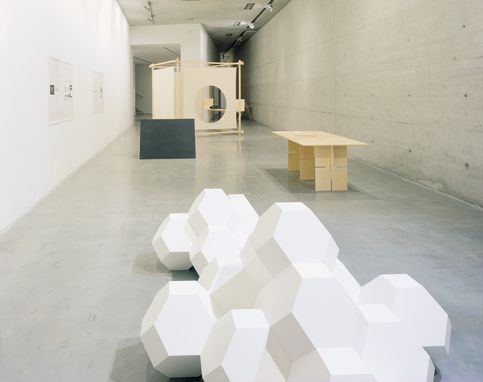On or off earth

Florian Pumhösl
On or off earth, 1996
"Design for the Real World and the Rhetorics of Alternative Movement" Adaption of creative and thematic concepts by Victor Papanek
Installation, 8 parts Total dimensions variable
GF0003365.00.0-2003
Artwork text
On or off earth, 1996 The design concept at the end of the sixties: a continuous need for constantly new forms and connotations for industrial products and a design industry that seemed to have established its game rules, giving its protagonists the feeling that their scope of activity was a wide-ranging. The “human engineer”—which is how Henry Dreyfuss defined one function of the industrial designer felt responsible for the technical, esthetic and educational functioning of the modern world with its unshakable belief in the improvability of things. However, design was also to play a central role in changing social paradigms and experiments: The concept was firmly established as part of the incipient ecological movement and the associated “critique of capitalism,” as formulated in Schuhmacher's bestseller “Small Is Beautiful”, for example. In his book “Ideologie und Utopie des Design” (Ideology and Utopia of Design), published in 1971, Gert Selle not only dismantles the romantic legend of the consistent self-realization of the modern in design since Morris but also poses fundamental questions about realistic principles allowing the profession to intervene in capitalist conditions of production. One year previously, Viktor Papanek’s book “Design for the Real World” had appeared for the first time in Sweden. It is a universalistic, polemic and idealistic critique of contemporary design and its critical role in creating social imbalance. Unlike Gert Selle or Tomàs Maldonado who, for example, criticized the discussion about ecology as a passing fashion created by mass media, Papanek starts from the assumption of a more universal, pragmatic space for design to operate in, ranging from design solutions for everyday objects through “nomadic” forms of dwelling and living to the solution of urgent problems in the Third World. The field of work thus outlined acts in many ways as a correction to the book “Designing for People” by Henry Dreyfuss, which came out in 1951. Papanek’s book presents similar concepts regarding the designer's scope of action in the conception of production and planning processes, but has a more far-reaching notion of social responsibility. Papanek’s ideological proximity to figures like Buckminster Fuller and Marshal McLuhan was a highly decisive factor in establishing “global” awareness. The aim was taking responsibility for spaceship earth (here, life raft earth) and looking after its essential structures and needs. In the wide-ranging debate on the subject, ecological and social problems, were usually analyzed as symptoms of industrial societies in general and not as a consequence of their political systems. The ideological scenarios of the Cold War gave rise to a strategy of circumventing political practice with “global” concepts and the subjectivization of social responsibility. It is in this context that some of the building blocks and basic ideological formations developed are still current) as ideological particles of capitalism with a human face; in our clichéd concepts of things like ecological and Third World production or in the attempts by industry to create a clean, human image for itself. “Small Is Beautiful, Do It Yourself, Think Global—Act Local, Recycling, Sustainable”: these are just some of the catchwords coined in the sixties and seventies that even today make up the vocabulary of the “alternative” philosophy underpinning the ideological background of “green” movements or “progressive” management concepts, for example. An exhibition about a “classic”, “Design for the Real World?” It seems inappropriate to test the validity and practicality of its designs and concepts—in the past 26 years, design theory and practice has tried them out with a greater or lesser degree of thoroughness. Many of the designs for the disabled, medical equipment or modular furniture were important forerunners of today’s industrial norms. Others ended up in the archives as “utopian dreams.” Nor is this meant to be an a social design theory update. The exhibition focuses more on the model character of Papanek’s concepts and parallel scenarios. On or off earth selects designs from within his sphere of influence and by means of texts and associated material, tries to reconstruct some of his themes. The lost packaging list, so to speak. (Friedl Kubelka)








